The summer downpour is not enough: Sardinian basins halfway, 247 million cubic meters less than in 2023
Impressive numbers from official monitoring: risk of restrictions also for domestic usersPer restare aggiornato entra nel nostro canale Whatsapp
A passing morning storm over southern Sardinia, but nothing more. This morning's rains do not serve to quench the island's great thirst, certified once again by the distressing numbers of the filling coefficients of the artificial reservoirs that supply water to the countryside and homes of the island.
The Sardinian basins are half full and some are even below this threshold. According to the monitoring of reservoirs and drought early warning by the Region's basin authority, the filling percentage is equal to 50.2%, 21 points below the same period in 2023: approximately 247 million cubic meters are missing.
In absolute terms, out of 1824 million cubic meters that can be invaded, on 31 July there were only 915.80 million available while on 30 June there were 1048.06 million, i.e. 57.4%.
The water crisis is evident in the countryside but what is worrying, in the absence of rainfall, is autumn. The rains arrive later and later and the restrictions, if it continues not to rain, may no longer only concern agro-livestock companies but also residential users.
Some municipalities have already taken action by looking for underground water wells and planning the installation of watermakers.
Thirst is felt more in the Sulcis (35%), but, apart from the Liscia reservoir in Gallura at 64% and the Tirso district (at 75.4%), all the other dams also have to deal with the little invaded water: from Ogliastra to Baronia, up to northern Sardinia. This year, not even the hydrographic area of Flumendosa-Campidano-Cixerri is saved where there is only 35.7% water.
It should also be considered that the costs for purification could increase: by fishing from the bottom of the basins, the water must be treated with more care and this increases the costs for the water manager, which are then reflected in the tariff for end customers.
(Unioneonline)
